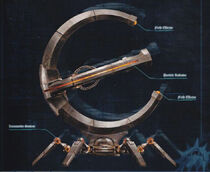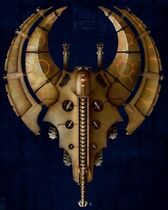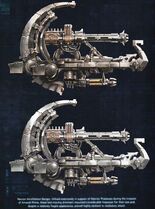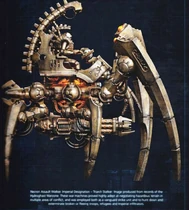m (→Slaughter: corrected Maynark to Maynarkh) Tags: Visual edit apiedit |
m (→History: Fixed grammar error) Tags: Visual edit apiedit |
||
| Line 13: | Line 13: | ||
==History== |
==History== |
||
[[File:Maynarkh_Necron_Warrior_Amarah_Prime_WZ.jpg|thumb|250px|An [[Ordo Xenos]] pict-file of a [[Necron Warrior]] of the Maynarkh Dynasty, spotted in Amarah Prime during the [http://warhammer40k.wikia.com/wiki/Orpheus_Sector#Portents_of_Doom Orphean War] ]] |
[[File:Maynarkh_Necron_Warrior_Amarah_Prime_WZ.jpg|thumb|250px|An [[Ordo Xenos]] pict-file of a [[Necron Warrior]] of the Maynarkh Dynasty, spotted in Amarah Prime during the [http://warhammer40k.wikia.com/wiki/Orpheus_Sector#Portents_of_Doom Orphean War] ]] |
||
| − | Long before the [[War in Heaven]], the Maynarkh already possessed a sinister reputation amongst its kindred. Unlike other Royal Courts of the Necrontyr, the Maynarkh stood out not only for their loyalty and courage, but also for their ruthlessness, their savagery in combat and their malice. Above all others, these traits were those that the Silent King openly valued, seeing in the Maynarkh not only faithful and loyal soldiers in the war against the servants of the Old Ones, and later on the [[C'tan]]s, but also red-handed agents of his own will. While the Maynarkh's honour was unquestioned, these qualities and their closeness to power made that some of the other courts openly distrusted the Maynarkh, considering them as distasteful and lacking in refinery, even going as far as calling them uncivilised. This general disdain for the Maynarkh quickly became common ground, even leading long-standing feuds between rivaling dynasties to be put aside in order to hinder the Maynarkh's advancement in the incessant power-plays, vendettas and intrigues that plagued the Necrontyr's highest echelons. This in turn led the Maynarkh to claim what they wanted through open violence and even outright relentless |
+ | Long before the [[War in Heaven]], the Maynarkh already possessed a sinister reputation amongst its kindred. Unlike other Royal Courts of the Necrontyr, the Maynarkh stood out not only for their loyalty and courage, but also for their ruthlessness, their savagery in combat and their malice. Above all others, these traits were those that the Silent King openly valued, seeing in the Maynarkh not only faithful and loyal soldiers in the war against the servants of the Old Ones, and later on the [[C'tan]]s, but also red-handed agents of his own will. While the Maynarkh's honour was unquestioned, these qualities and their closeness to power made that some of the other courts openly distrusted the Maynarkh, considering them as distasteful and lacking in refinery, even going as far as calling them uncivilised. This general disdain for the Maynarkh quickly became common ground, even leading long-standing feuds between rivaling dynasties to be put aside in order to hinder the Maynarkh's advancement in the incessant power-plays, vendettas and intrigues that plagued the Necrontyr's highest echelons. This in turn led the Maynarkh to claim what they wanted through open violence and even outright relentless and unrelenting aggression where other dynasties made use of far more subtle means: for instance, those lesser dynasties bound in service to the Maynarkh most often did this under the threat of extermination. This in turn fuelled the Maynarkh's reputation for brutality. The [[Nemesor]]s of other dynasties might have condemned the Maynarkh's lack of subtlety and strategic elegance, none could deny the brutal effectiveness of the Maynarkhs. |
The Maynarkh's true actions in the War in Heaven are the matter of some conjecture, for even the oldest and greatest overlords of the Necron crownworlds remember well the truly ancient battles against the star gods, for the truly horrific weapons unleashed to destroy the C'tans damaged causality itself. Furthermore, in his constant paranoia that these weapons might be turned against him, the Silent King erased the memories of all of his servants, even the most trusted ones. To further guarantee the Maynarkh's loyalty, the Silent King implemented powerful command protocols during the biotransference process that effectively turned the Maynarkh dynasty into his personal henchmens and executioners. Legend has it that it was by the hands of the Maynarkh that the C'tan known as [[Llandu'gor the Flayer]] was not only defeated and shattered, but truly obliterated. With his last breath, the defeated C'tan is said to have cursed the Maynarkh, infecting them with a measure of his own terrible hunger for life, and certainly the demeanor of the reawoken Maynarkh lend weight to this dark legend. It is also interesting to notice that following the destruction of the Flayer, perception of the Maynarkh was further altered, as the first cases of the Curse manifested within the rank of the Maynarkh, letting devolve some of the once proud warriors into grim and fleshhungry [[Flayed Ones]]. Slowly, the Curse of the Flayer began to creep through their ranks, moving higher up the echelons even before the Necron entered hibernation. The "''stench of blood''" that began to gather around the Maynarkh further stained the dynasty’s reputation and the Maynarkh were gradually perceived as little more than outcasts, banished to the desolate, lifeless and turbulent regions of the galactic South-West. |
The Maynarkh's true actions in the War in Heaven are the matter of some conjecture, for even the oldest and greatest overlords of the Necron crownworlds remember well the truly ancient battles against the star gods, for the truly horrific weapons unleashed to destroy the C'tans damaged causality itself. Furthermore, in his constant paranoia that these weapons might be turned against him, the Silent King erased the memories of all of his servants, even the most trusted ones. To further guarantee the Maynarkh's loyalty, the Silent King implemented powerful command protocols during the biotransference process that effectively turned the Maynarkh dynasty into his personal henchmens and executioners. Legend has it that it was by the hands of the Maynarkh that the C'tan known as [[Llandu'gor the Flayer]] was not only defeated and shattered, but truly obliterated. With his last breath, the defeated C'tan is said to have cursed the Maynarkh, infecting them with a measure of his own terrible hunger for life, and certainly the demeanor of the reawoken Maynarkh lend weight to this dark legend. It is also interesting to notice that following the destruction of the Flayer, perception of the Maynarkh was further altered, as the first cases of the Curse manifested within the rank of the Maynarkh, letting devolve some of the once proud warriors into grim and fleshhungry [[Flayed Ones]]. Slowly, the Curse of the Flayer began to creep through their ranks, moving higher up the echelons even before the Necron entered hibernation. The "''stench of blood''" that began to gather around the Maynarkh further stained the dynasty’s reputation and the Maynarkh were gradually perceived as little more than outcasts, banished to the desolate, lifeless and turbulent regions of the galactic South-West. |
||
Revision as of 19:57, 12 September 2016
The Maynarkh Dynasty forms one of the subdivision to the Necron race and is perhaps alongside the Sautekh Dynasty one of the most military-minded and powerful ruling dynasties of their entire race. Conquerors and exterminators, the Maynarkh have always been loyal servants of the Silent King, often acting as his right hand to punish those that would oppose him. This has earned them the hostility of many other dynasties, many of whom which would have preferred for the Maynarkh to be destroyed or never to be reawoken at all, but loathe to lose such a precious tool, the Silent King had taken special precautions to ensure that the Maynarkh would survive their 60 million year long slumber. The Maynarkh only recently awoke from their stasis-tombs and the Undying Legions of the Maynarkh were responsible for the utter devastation and loss of the Orpheus Sector, on the exterior border of the Segmentum Tempestus of the Imperium of Mankind. In what has since then been called the Orphean War, the reawakening Maynarkh Dynasty has brought an entire Imperial Sector low, their further intentions are unknown.
History

An Ordo Xenos pict-file of a Necron Warrior of the Maynarkh Dynasty, spotted in Amarah Prime during the Orphean War
Long before the War in Heaven, the Maynarkh already possessed a sinister reputation amongst its kindred. Unlike other Royal Courts of the Necrontyr, the Maynarkh stood out not only for their loyalty and courage, but also for their ruthlessness, their savagery in combat and their malice. Above all others, these traits were those that the Silent King openly valued, seeing in the Maynarkh not only faithful and loyal soldiers in the war against the servants of the Old Ones, and later on the C'tans, but also red-handed agents of his own will. While the Maynarkh's honour was unquestioned, these qualities and their closeness to power made that some of the other courts openly distrusted the Maynarkh, considering them as distasteful and lacking in refinery, even going as far as calling them uncivilised. This general disdain for the Maynarkh quickly became common ground, even leading long-standing feuds between rivaling dynasties to be put aside in order to hinder the Maynarkh's advancement in the incessant power-plays, vendettas and intrigues that plagued the Necrontyr's highest echelons. This in turn led the Maynarkh to claim what they wanted through open violence and even outright relentless and unrelenting aggression where other dynasties made use of far more subtle means: for instance, those lesser dynasties bound in service to the Maynarkh most often did this under the threat of extermination. This in turn fuelled the Maynarkh's reputation for brutality. The Nemesors of other dynasties might have condemned the Maynarkh's lack of subtlety and strategic elegance, none could deny the brutal effectiveness of the Maynarkhs.
The Maynarkh's true actions in the War in Heaven are the matter of some conjecture, for even the oldest and greatest overlords of the Necron crownworlds remember well the truly ancient battles against the star gods, for the truly horrific weapons unleashed to destroy the C'tans damaged causality itself. Furthermore, in his constant paranoia that these weapons might be turned against him, the Silent King erased the memories of all of his servants, even the most trusted ones. To further guarantee the Maynarkh's loyalty, the Silent King implemented powerful command protocols during the biotransference process that effectively turned the Maynarkh dynasty into his personal henchmens and executioners. Legend has it that it was by the hands of the Maynarkh that the C'tan known as Llandu'gor the Flayer was not only defeated and shattered, but truly obliterated. With his last breath, the defeated C'tan is said to have cursed the Maynarkh, infecting them with a measure of his own terrible hunger for life, and certainly the demeanor of the reawoken Maynarkh lend weight to this dark legend. It is also interesting to notice that following the destruction of the Flayer, perception of the Maynarkh was further altered, as the first cases of the Curse manifested within the rank of the Maynarkh, letting devolve some of the once proud warriors into grim and fleshhungry Flayed Ones. Slowly, the Curse of the Flayer began to creep through their ranks, moving higher up the echelons even before the Necron entered hibernation. The "stench of blood" that began to gather around the Maynarkh further stained the dynasty’s reputation and the Maynarkh were gradually perceived as little more than outcasts, banished to the desolate, lifeless and turbulent regions of the galactic South-West.
Yet, despite the pressures of other indeed more powerful dynasties, the Silent King did not abandon the Maynarkh and continued to show them his favours. To further taint the Maynarkh's reputation, their rivals gave birth to a series of dark rumors, which have increasingly become intertwined with the truth. In the backrooms of Necron politics, the Phaerons of the Sautekh and the Atun Dynasties secretly plotted for the destruction of the Maynarkh in a last effort to cleanse their ranks before entering the Great Sleep. However the Silent King would have none of it, for he had still use for the troops of the Maynark and went to great efforts to ensure that the Maynarkh would survive their long hibernation. As part of these efforts, the Maynarkh's crownworlds were not merely hidden from outside eyes, but even from the other Necron Dynasties. The Silent King spared no expense to ensure that upon their awakening, the Maynarkh would be able to answer his call, ensuring that the Maynarkh’s Tomb Worlds were equipped with solar manipulator arrays and hyperspatial flux generators to keep them out of harms way. In this, the forced exiled of the Maynarkh was a boon, for the region of space allotted as their domain was frequently visited by Warp Storms and other celestial calamities.
The Great Sleep
As preparations for the Great Sleep progressed and time passed, the effect of the Curse of the Flayer began to take its toll. After the lower orders, the Maynarkh's upper echelons were increasingly succumbing to the Curse. Those that did not succumb outright to the Curse were profoundly altered, their patience increasingly diminished by a growing bellicose temper, which gradually turned into an unearthly bloodlust and ended in a descent into homicidal madness. Like a ghost in a matrix, the Maynarkhs clung to their ancient war codes and ritualised pattern of war in a vain hope that this madness could be tempered or harnessed by their honour as warriors, but in doing so they perverted their own ideals. While fanatical adherence to this code of conduct was once expected, the Maynarkh's ruthlessness became a compulsion, a thirst to be slaked before the next genocide could be enacted.
In the meantime, in their own paranoia or perhaps as the first sign of the Curse, the Maynarkh’s Overlords themselves tasked their Crypteks to create an ever-growing variety of war machines and Canoptek guardians, further equipping their dynasty in order to wage war on its enemies and increasing their own defences. It is generally believed that it was at this moment, sixty million years ago that such baleful machines as the Tomb Stalker and the Acanthrite were invented. The ruling classes of the Maynarkh where under no illusion that the Great Sleep might stop the Curse, and indeed many if their numbers supposed that it would rather mark the slow death knell of their dynasty, that in the silence of the stasis-crypts the Curse would worm its way into the Maynarkhs over the millennia and that only a tide of ravenous ghoul-automata would emerge, mindlessly trying to slake their unquenchable thirst for blood and hunger for flesh. Basically, the Maynarkh feared to succumb to the same fate that would befall the Bone Kingdom of Drazak, or the Oroskh Dynasty. Yet when the time came to enter the Great Sleep, still bound by the Silent King’s command, all of the Maynarkh entered the hibernation-process that would see the Necron reemerge in the 41st Millennium.
The Silent King’s foresight and the Maynarkh's own paranoia would see to it that the dynasty passed true the eons relatively unscathed, for the Maynarkh's Tomb Worlds had been well hidden, protected by layer after layer of concealment and murderous defences. Far better shielded from the stellar phenomena that would ravage other Tomb Worlds, the Maynarkh's crownworlds slept largely undisturbed as the barrenness of space they now colonized offered little of interest to those races that would eventually emerge after the Necrons. To watch over the Maynarkh, the Silent King had appointed his own guardians, the Triarch Praetorian to protect his cherished ad valuable warriors. Due to the Maynarkh’s own paranoia, these guardian intelligences and their Canoptek servitors kept a close eye on the neighbouring worlds and on the rare occasion someone ventured into the Maynarkh’s domain, they were met with violence. The Maynarkh's praetorians were not merely content with eliminating the trespassers themselves, but actively sought and destroyed the nearest population center or star vessel from which the trespassers had come. To achieve these goals, the Triarch Praetorians did not rely solely on the Canoptek killing engines at their disposal, but time and time again awakened entire Necron Phalanxes to ensure their victory. This overt aggression could have considerably backfired, calling down a greater wrath than the sleeping Tomb Worlds and their guardians might have been able to handle, but thankfully for the Maynarkh, the short-sightedness of the younger races and the isolation of their domain ensured that no such threat emerged. Even the greatest threat to the Maynarkh, the birth of the Imperium of Mankind and its Great Crusade did not suspect what lay slumbering beneath the worlds of the later Leyak and Orpheus Sector.
For millions of years, the Canoptek guardians and their Praetorians watched over the Maynarkh, waiting for the Silent King’s command to reawaken the powerful dynasty. At the preordained time and moment, these constructs would deactivate the Tomb Worlds stasis-crypts and summon the Undying Legions of the Maynarkh to march again. This moment was chosen to coincide with a stellar phenomena of such magnitude and accuracy that it could not be missed by the crude intelligence of the Canoptek guardians: the death of a sun, or rather of two suns, for the Caracol-system was a binary star-system. No Necrons slumbered in this system for it had been one of the great domains of their ennemies, the C’tans, and the location of one of their powerful devices they had used during the War in Heaven: the Dolmen Gate - a powerful artefact able to transfer energy from the material plain into the Immaterium. The Silent King planned on the Caracol-system’s death to shatter the Dolmen Gate and cause such an unusual Warp phenomena that it could not be misinterprated by his servitors. This very specific event would mark the Reawakening of the Maynarkh. By the Imperial Calendar, this event occurred in 990.M41, although the reason for Caracol’s two suns to go supernova way ahead of their natural life span remains unknown. Was it a mere rogue accident of nature or somehow ordained by the hand of the Silent King? Or did possibly older, far darker powers mettle with it? None can say for sure. The suns’ fiery death shattered the planets of the Caracol-systems, destroying the last ruins of the C’tans presence, but even as it was destroyed, the Dolmen Gate converted the fiery death into pure energy that was magnified and transferred into the Warp as a great bow-wave, rippling its surface like a stone thrown into a pond and calming the face of the Aether. This ripple in the Warp purely snuffed out the Warp turbulences that had been plaguing the Orpheus Sector for centuries, with the notable exception of the particularly fierce Warp Storm known as the Howling Vortex to the Sector’s East. Hundreds of Astropaths burned out and thousands perished as their ships were broken in two and ripped apart by frenzied daemons, but the Necrons did not care for these death. For all intents and purposes, the ordained time had come : the Maynarkh needed to be awakened.
Slaughter
On distant worlds, the stasis-crypts of the Maynarkh were opened, and the Dynasty’s true fate revealed. Thousands of Necrons awoke from their near-eternal slumber howling for the blood and flesh of the living, undone by the Curse of the Flayer. On every Tomb World, these insane automata gathered together as ravening packs of Flayed Ones, desperately seeking living flesh for their claws to carve, but bound to find none. Other warriors and Necrons quickly swelled their ranks succumbing to the Curse in a matter of hours, days, weeks or months. However many thousands of Necron Warriors, Lychguards and other construct emerged unscathed from their stasis-crypts and dutifully assembled, waiting for their Crypteks and Overlords to emerge. Yet without leadership, these warriors simply stood by, waiting for their masters to return to them.

Unidentified Necron Lord affiliated to the Maynarkh Dynasty.
The higher echelons of the Maynarkh appeared less affected by the Curse, their bloodlust as living creatures before the biotransference project leaving them perhaps a measure of immunity, as if sensing some strange kinship, the Curse of the Flayer had not entirely taken root. Some had indeed succumbed to it, but far more of the nobles and Crypteks now bore the Curse of the Flayer deeply embedded within their cybernetic consciousness. While the Curse did not control them, it had however corrupted the personality of many members of the Royal Courts : martial honour had been forgotten and simple and brutal extermination had replaced the glory of war. Awakening from the Great Sleep, many of the lesser nobles recoiled from what they had become. The vague hope they had shared of perhaps returning to an existence of flesh and bone irremediably crushed. Truly, they were lost and many descended into delusion and madness. Some embraced the nihilistic tendencies and the hatred of all life they harboured within their cybernetic cortexes and gave themselves over for body modification, becoming Destroyers, while other embraced the carnage yet to come. The Maynarkh Dynasty truly stood on the brink of tearing itself apart, nearly falling in a spiral of self-destructive anarchy, until the last and most heavily protected of the stasis-crypts opened, releasing the Maynarkh’s true ruler and Phaerakh : Xun'bakyr, the Mother of Oblivion. With her came the Maynarkh’s most powerful and fearsome leaders, Maktlan Kutlakh the World Killer , lazolt the Faceless, Nemesor of Tayroc, and Ixatothek, the Jackal Regent, Lord-hunter of the void. Together, these powerful individuals reassessed control of the Maynarkh and kept it from destroying itself.
With brutal willpower, the ruling lords of the Maynark brought order to their undying legions and their reawakeing tomb worlds. In the deepest, coldest and airless black vaults, a council was held, the severely corroded Triarch Praetorians standing before the ruler of the Maynarkh Dynasty and reporting what had ocurred during the millions of years since the Necrons had walked amongst the stars. The rulers of the Maynarkh were infuriated by the myriad of vermin-races that had prospered since they had entered the Great Sleep. It was roughly at that time that the powerful Overlords recognized that the command protocols implemented by the Silent King had worn off. Now free to act upon their own will and desire, the Maynark convened a second council, consulting their mightiest Chronomancers who called upon their strange devices to pierce the veil of distance and time. Other tomb worlds of other dynasties were discovered, still asleep or in the process of awakening, and the fires of ambition began to burn again in the cold machine eyes of the Maynarkh ruling council. Now was the time to act and take the supremacy that had been denied to them in distant past. The neighbouring dynasties would be subjugated or destroyed and bound to their ultimate goal: genocide, the systematic and merciless destruction of all lifeforms that would oppose them, and the first to feel their wrath would be the nuisance identified as "Mankind". This then would not be an honorable war between two opponents of equal valour, but an extermination campaign on an interstellar scale, a dark harvest of the living whose flesh, bones and blood would sate the hunger of the afflicted children of the Maynarkh, playthings and nourishment as a small mercy upon the damned, or so the Maynarkh told themselves.
Yet the Maynarkh would not rush headlong into battle: there were still more warriors to be awakened, more legions to marshall and more weapons to be tested before this dark harvest could begin, and so careful plans were laid, probing borders, studying their foes, isolating its enemies. With a spider’s patience, the Maynarkh spun their web around the Orpheus Sector. Only when everything had been accomplished according to the Mother’s will would the Maynarkh reveal themselves. Only then would the Orphean War begin.
Notable Campaigns
- The Orphean War (991.M41 - 999.M41) – Having reached their intended strength, the Maynarkh Dynasty attack the Imperial Orpheus Sector on the edge of Segmentum Tempestus. The attack is proceeded by a communication black-out which leaves the Orpheus Sector cut in two. The Necrons advance in two distinct lines of battle: one advance invading the Sector from the Outer Darkness, with a second advance entering the Sector from the South, and the territories of the former Leyak-Sector. Unable to call for help, the entire Eastern half of the Orpheus Sector succumbs quickly, only the Space Marines of the Angels Revenant Chapter putting up a true fight, but even their sacrifice is not enough to stop the xenos advance. A hundred days after the offensive began, the silence is broken and a tide of astropathic warnings and distress signals reaches the Orpheus Sector’s capital, Amarah Prime. Only now realizing that it has come under attack, the Imperium mobilizes its vast armies, which however cannot prevent the Drucillan Sub-Sector to be overrun. Led by their greatest Nemesor, Maktlan Kutlakh, the Necron inexplicably stop their advance after a hundred days; as tradition demands it, their enemy would be given two cycles of the moon to prepare themselves to meet their death. The Orpheus Sector’s Imperial Governor, Calibor Laan uses this time to turn his world, Amarah Prime, into a fortress, stripping other worlds of their defences and transferring them to Amarah. Crusading forces and reinforcements alloted to the purge of the chaos-riddled Chemarium-system are rerouted to Amarah, including armies drawn from the Necromundan Regiments and the fearsome Death Korps of Krieg of the Imperial Guard. Most importantly perhaps, an entire Space Marines Chapter, the Minotaurs under their Chapter Master Asterion Moloc join the defenders of Amarah. And yet, this stronghold of Imperial might is laid low in a single day, almost entirely destroying the powerful battlefleet defending Amarah and lading their troops unopposed on the surface, the Necron prove their superiority. Had it not been for the desperate counter-attack of the Minotaurs’ fleet and the stoic resistance of the Death Korps, total victory woud have been achieved. Yet through great sacrifices and bloody determination, Asterion Moloc faced Kutlakh on the bridge of the Matklan's flagship, the Cairn-class Tomb Ship Dead Hand. The Minotaurs' Chapter Master and his elite 1st Company veterans succeeded in wounding Kutlakh, before being sucked into the void. Having not anticipated this level of stubbornness, the Necron retreated with something akin to respect for this vermin which had settled upon their worlds. For the Imperium however, the losses of the Battle of Amarah are so severe that the Sector has to be abandoned and dissoluted. The fighting however continues as the Undying Legions progress westwards and the Imperium tries to salvage what it can from the remains of the Orpheus Sector.
Military Strength
It comes as no surprise that the notoriously aggressive and military-minded Maynarkh counts perhaps as the single most powerful Necron dynasty yet encountered by Mankind. Several facts concur to explain this status, as first the Maynarkh were already counted amongst the most powerful armies of the Necrontyr before the War in Heaven. Secondly, the coreworlds of the Maynarkh lie beyond the domains of the Imperium of Mankind and were far better shielded than the worlds of other dynasties. Therefore, the Maynarkh have emerged from the Great Sleep almost unscathed in numbers, if not in mind, where other dynasties have considerably suffered.
As exemplified by the Battle of Amarah during the Orphean War, the legions of the Maynarkh are both vast and formidably equipped. As a whole, these Phalanxes seem to match the standard of other dynasties, but also feature such terrifying warmachines as the Annihilation Barge and the much more powerful Tesseract Ark, which was first encountered during the Orphean War. it has been noted that the Maynarkh display a noted preference for mass infantry assaults to bring their enemy to heel by pure and bloody attrition where the Necron’s self-repair protocols balance the odds even against superior and entrenched foes. It is believed that the Maynarkh Dynasty fielded over two millions Necron Warriors during their invasion of the Orpheus Sector, a testimony to their strength. Where other Necron dynasties lack long range artillery support, the Maynarkh Dynasty routinely fields Necron Sentry Pylons as both field artillery and anti-air defence systems. In stark constrast to these same dynasties, the Maynarkh also make use of highly specific and until recently fairly unique Canoptek constructs in the role of shock-troops; the first confirmed sightings of the much dreaded Canoptek Tomb Stalker and its variant the Tomb Sentinel, as well as the Canoptek Acanthrite were made amongst the legions of the Maynarkh. On a tactical level, the Undying Legions of the Maynarkh also strongly rely on air-support to destroy the most dangerous enemies and thus make a large use of the lighter Doom Scythe and the heavier Night Shroud. During the Battle of Amarah, the Maynarkh’s first preoccupation was to overwhelm Imperial air-defence and obtain aerial superiority.
The Lords and Overlords of the Maynarkh also manifest a far more bellicose temper than the rulers of other dynasties, taking pleasure in bringing enemy champions low and most often leading their troops from the front rather than the rear.
Known Client Dynasties
- The Vralekth Dynasty - The Imperium encountered the Vralekth Dynasty during the Orphean War on the former Agri-World of Hydroghast, from which they are supposed to originate from. As Hydroghast is an Ocean World, the Vralekth stasis-tombs had slumbered for millennia in the deepest abysses of Hydroghast's oceans, the great depth sheltering them from prying eyes. As a side-effect of this aquatic terrain, the warriors of the Vralekth distinguish themselves by a high degree of corrosion on their Necrodermis, although this seemingly did not impact on their combat effectiveness. It remains however unclear if the Vralekth are truly a Client Dynasty or a possible scion or offshoot of the more powerful Maynarkh Dynasty.
The Maynarkh Fleet
Where other dynasties still seem to control part of the ancient network of Dolmen Gates established by the C’tans, the Maynarkh do not seem to have access to such technology and therfore rely strongly upon their powerful warfleet to transport their troops across space. As such, the Maynarkh Fleet is also currently the most well documented Necron Warfleet in Imperial history, having attacked and indeed emerged victorious from a a fight with a full Sector Battlefleet during the Battle of Amarah. Post action-reports therefor place the Maynarkh Fleet at a hundred or so Escort-class ships such as the Shroud-class Light Cruiser and twenty Cruiser-level Scythe-class Harvest Ships. This powerful fleet is commanded by two of the dreadful and gigantic Cairn-class Tomb Ships identified as the Sun Killer and the Dead Hand, which acted as flagship to Maktlan Kutlakh in the Orphean War.
Known Entities of the Maynarkh
Information regarding the leaders of the Maynarkh Dynasty are scarce at best, as currently the Imperium has positively identified only one of these figures, Maktlan Kutlakh as he led the armies of the Maynarkh against the Orpheus Sector. What little information has been gathered was gained through the study of ancient steles and fragments of masonry of ancient xenos temples, believed to have been erected by the Necrontyr.
- Phaerakh Xun'bakyr, the Mother of Oblivion - Believed to be the supreme leader of the Maynark Dynasty. The association of both names strongly suggest "Phaerakh" to be the female equivalent of the more common title of Phaeron, which would effectively make the Maynarkh the first known Dynasty to be ruled by a female Overlord.
- Maktlan Kutlakh, the World Killer - The entity designated as Kutlakh is currently believed to be the highest ranking Nemesor of the Maynarkh Dynasty. His official title, Maktlan loosely translates as "the Extinguisher of Life", but Kutlakh also carries other titles such as "the Charnel Lord" and "the God-Slayer" which mark his prominent position within the Dynasty. Kutlakh was positively identified as leading the Necron troops during the Battle of Amarah, during which he was confronted by the notoriously brutal and deadly Chapter Master of the Minotaurs’ Space Marine Chapter, Asterion Moloc. Although Moloc succeeded in wounding Kuthlakh, given he regenerative capacities of the Necron Necrodermis, Kutlakh is certainly still at the head of the Legions of the Maynarkh as they inexorably advance through the Orpheus Sector.
- Tlazolt the Faceless, Nemesor of Tayroc
- Ixatothek, the Jackal Regent, Lord-hunter of the void
- Toholk the Blinded, Master of the Eternal Engines - Toholk the Blinded holds the position of Arch-Cryptek of the Maynarkh, for he is a masterly gifted weaponsmith and armourer. Toholk is obsessed with destruction, craftig ever more devastating weapon which have often served as valuable technologies to be traded with other Dynasties. Yet his genius and notoriety have caused many griefs amongst both the Royal Courts and the Crypteks of the Maynark which have tried to dispose of Toholk on numerous occasions. Even his true masters fear Toholk and have crippled his mechanical body, while his mind has been shackled with the most powerful command-protocols at their disposal. Toholk greatest and latest achievement is a celestial scanning and temporal prediction device called the Smoking Mirror which allows Toholk to predict the future.
Notable Domains
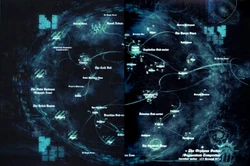
Imperial Departmento Cartographicae galaxy map of the Orpheus Sector
The Ordo Xenos of the Emperor’s Holy Inquisition has thus far been unable to positively identify which planets truly belong to the Maynarkh’s domains, but all clues indicate that at least a portion of the former Orpheus Sector was established on former worlds belonging to the Maynarkh empire. It is generally agreed upon that the Maynarkh’s coreworlds do not lie within the Orpheus Sector proper but beyond the Veiled Region from which no human Explorator is believed to have ever returned. In wake of the ongoing Orphean War, many have also suggested that this might have been the case for the former Leyak Sector, which ceased to exist in 976.M37 after having been raided and destroyed by unidentified enemies - enemies now believed to be an awakened portion of the Maynarkh Dynstasty. Several other unexplainable events of death on a planetary scale have also been blamed on the reawakening Necron, as for instance the Death of Tlaloc in 889.M38 and the mysterious disappearance of the first colonization fleet sent to the exact same world in 817.M36. However, the reasons for which the Necrons seem to have such a great interest in this world still elude the savants and Inquisitors of the Ordo Xenos.
- Drucilla Majoris (Imperial World) - Head of the former Drucillan Sub-Sector, this world was known before well before the Orphean War to harbour xenos ruins, which are believed to have played a capital role in the faith of the deluded members of the Cult Celestarii, a seditious cult which venerated divine being that closely resemble the Necrons.
- Hydroghast (Ocean World) - Located within the autonomous region known as the Barren Stars in the galactic East of the Orpheus Sector, Hydroghast was formerly used as an Agri-World by the Imperium of Man, great factories transforming the animal and vegetable bounties of Hydroghast's deep oceans into nutrients and food for the entire Sector. None suspected that in great depths the ocean floor might harbour stasis-crypts and tomb complexes of the Necrons. From what pic-captures could be recovered, it would seem that Hydroghast was and still is the principal Tomb World of the Vralekth Dynasty which serves the Maynarkh.
- Thamyris (Abandonned World) - With the awakening of the Maynarkh Dynasty and their attack on the Orpheus Sector, strange structures - obviously of xenos origin - have begun to rise from the sand of Thamyris in the Deluvian Sub-Sector, which is located to the galactic South of the Orpheus Sector. Plagued by strange and unexplainable disappearances of mining teams and Explorator-parties, Thamyris was never truly colonized, but it was still periodically visited by Man, as the sand of Thamyris' deserts harboured rare elements and some xenologist were interested in the great complex of prehuman ruins discovered there of which the greatest was known as the Haunted Palace. While Necron presence has been confirmed, Thamyris true purpose remains a mystery. This was however enough for the Imperium to schedule a full-fledged counter-attack on the Necrons.
Maynarkh Appearance
The Maynarkh Dynasty mainly distinguishes itself by the orange glow of their powersources and weapons its warriors wields, as well as the notable absence of gold decorations, whereas brass is much more common. The Necrodermis of the Maynarkh Dynasty is also prone to take on a more brassish hue than the standard silver or metallic hue more common to other dynasties. Particularly on Hydroghast, the warriors and constructs that took to the field of battle also figured heavy marks of corrosion, further accentuating the orange glow of the Necron's powersources and weaponry. Except for the Maynarkh's aircraft, which supported an uniform brassish or ochre drab, vehicles were also largely left unadorned and blank metal, which shades varying from dark gunmetal to almost silver.
See Also
Sources
- Imperial Armour Volume Twelve – The Fall of Orpheus, pp. 89-92, 108-111

